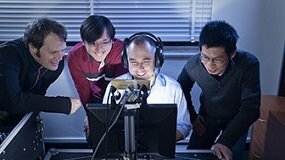Last updated May 18, 2017 at 10:22 am
Meet two researchers at the cutting edge of wearable tech.
DR JULIEN EPPS
Associate Professor in Signal Processing, University of NSW
 What do you work on? Wearables worn on the head. I love sensors, and a great place to put sensors is on the face, because that’s where a lot of interesting things happen. I’ve been working on understanding human emotional and mental states by tracking behavioural signals; things like speech, eye activity and body movement. I love it.
What do you work on? Wearables worn on the head. I love sensors, and a great place to put sensors is on the face, because that’s where a lot of interesting things happen. I’ve been working on understanding human emotional and mental states by tracking behavioural signals; things like speech, eye activity and body movement. I love it.
How did you get here? My background is electrical engineering at UNSW.
Advice for people wanting to work in your area It’s surprising how quickly you can learn by using online tools. Be curious. Start investigating things. Wearables are a huge world of opportunity, because there are so many things you could do.
What do you see for the future? Entire industry sectors will be invented because of wearables. Within a generation, a lot of the things we’ll be wearing will be electronic, or have functionality embedded in them. A lot of the things we’re going to take for granted haven’t been invented yet. There’s a huge revolution about to happen.
Image credit: UNSW
DR JASMINE PROUD
Biomechatronics engineer, Victoria University, Melbourne
What’s your focus? Research into wearable robotics: I have a passion for assistive and rehabilitation technology. I’m looking at electroactive polymers [materials that change size or shape when activated by electricity] and whether they can be used in hand exoskeleton applications [artificial hands].
How did you get here? I did sports engineering at Victoria University, Melbourne. I was really into fitness sports and wanted to engineer for people. Both my grandparents had strokes, and that’s what prompted me to ask what’s out there for rehabilitation?
During my degree I did two internships in robotics, and that’s where I really found my passion. I thought about it for a couple of years, then I built a hand exoskeleton for stroke rehabilitation in my final year. I 3D-printed the hand components, built the electronics and made it all wireless, with a user interface and realtime graphing so you could see improvements in hand function.
Advice for people wanting to work in your area Engineering isn’t just about bridges, concrete and cars. It’s about taking real-world problems and creating solutions. You can do anything you’re passionate about with engineering. Think broader. Think bigger. How can you make a difference?
What do you see for the future? I think wearable robotics will be used with augmented reality to create really amazing rehabilitation tools.
Image credit: Victoria University
Cris Burne has worked as a science writer, editor and presenter in Switzerland, the US, UK, Japan and South Africa. She now lives and works in Perth.
Originally published in Ultimate Careers magazine. Read the magazine and find your Ultimate Careers here.
Follow us on Facebook, Twitter and Instagram to get all the latest science.
































































































































































































































































